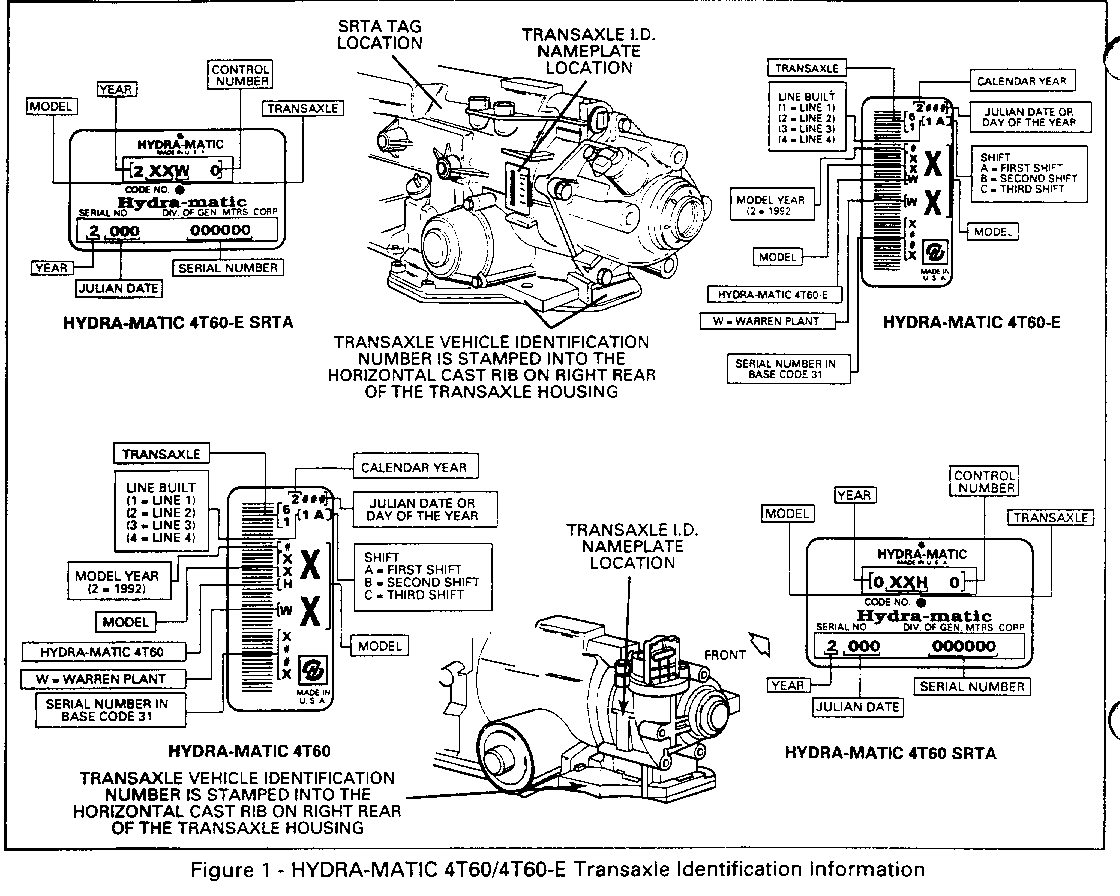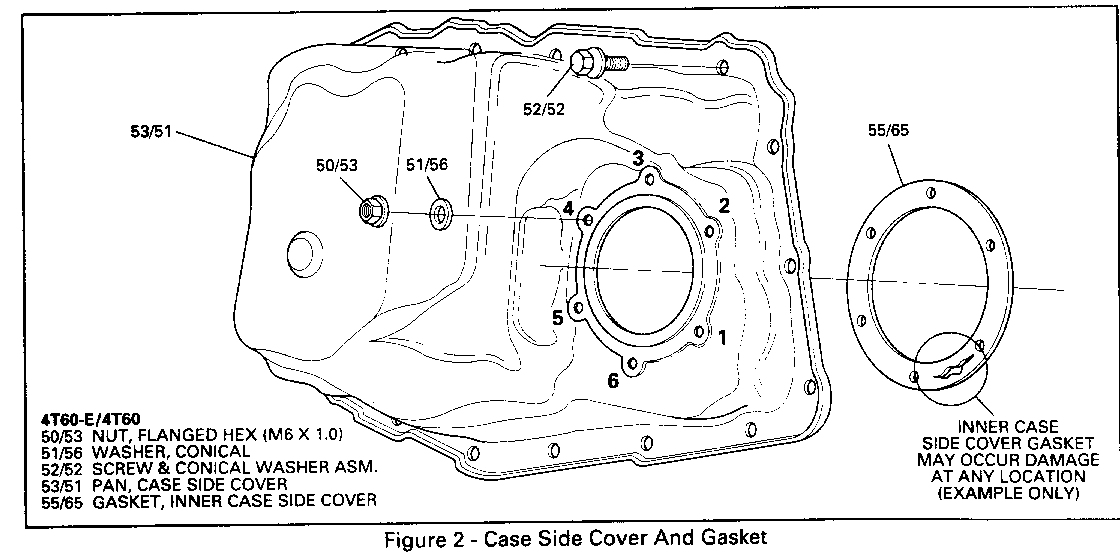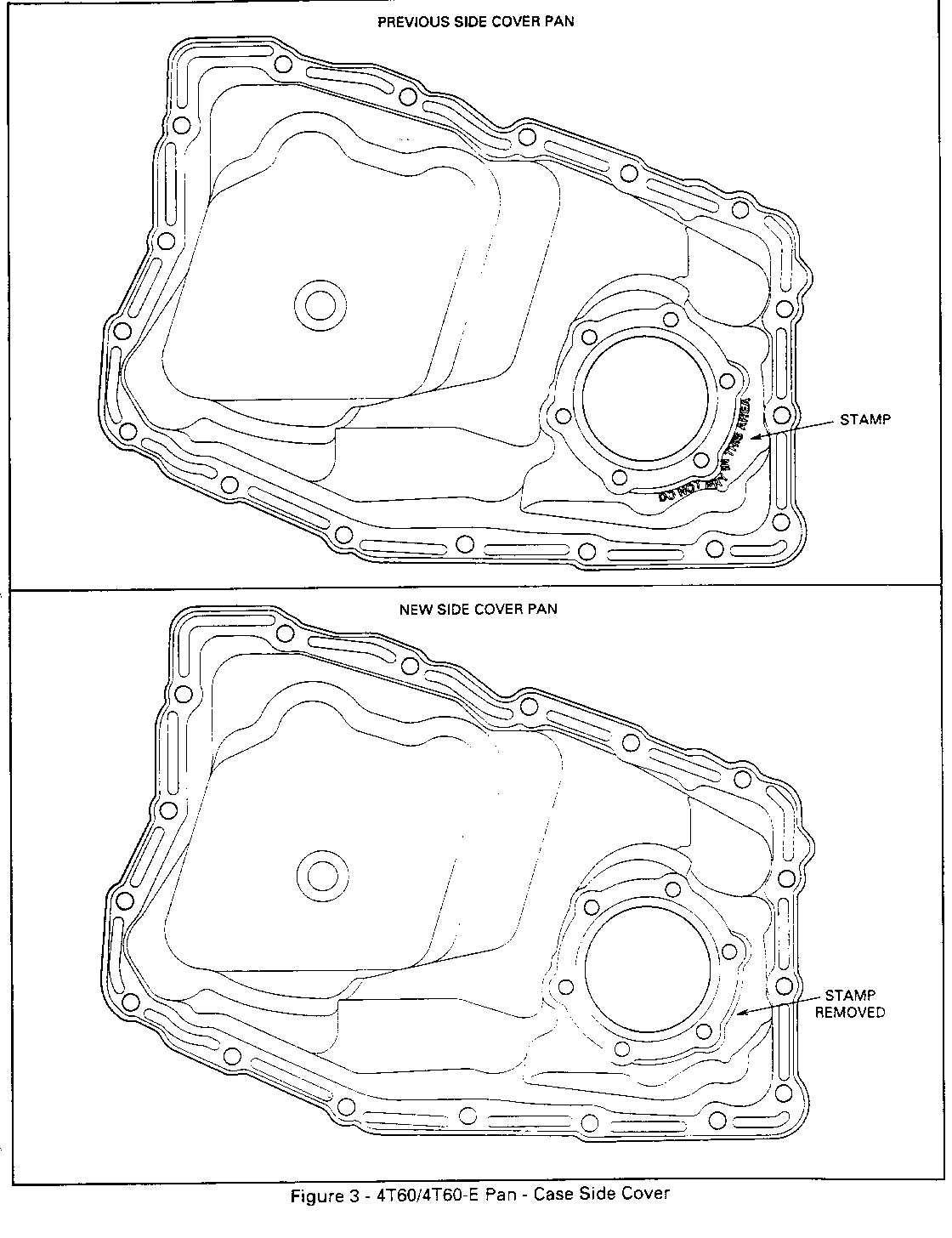TRANSAXLE FLUID LEAK 4T60E (INSTALL NEW SIDE COVER PAN)

SUBJECT: Transaxle Fluid Leak at Inner Side- Cover to Channel Plate Gasket (Install New Side-Cover Pan)
VEHICLE APPLICATIONS: Chevrolet W Cars / U-Van Pontiac A, H, W Cars / U-Van Oldsmobile A, C, E, H, W Cars / U-Van Cadillac C, E, K, V Cars
TRANSMISSION APPLICATIONS: 1991-92 HYDRA-MATIC 4T60 (ME9) 1991-92 HYDRA-MATIC 4T60E (M13)
TRANSAXLE MODELS: All
THIS BULLETIN IS BEING REVISED TO CHANGE INFORMATION IN THE CAUSE AND CORRECTION SECTIONS.
CONDITION: (Figure 1) --------------------- Upon inspection or notification by customers, technicians may find automatic transmission fluid seeping from the side pan of 4T60 and/or 4T60E HYDRA-MATIC transaxles. In some situations, the leak may be mistaken for distressed 4th clutch (refer to Product Service Bulletin 90-7440-110 for more information on distressed 4th clutch). Depending on the amount of fluid lost, a customer's vehicle may exhibit any of the following conditions:
* Delayed Engagement (verify leak side-cover) * No Drive In Drive Range * Slips In Drive * Intermittent Flares on Shifts * Intermittent Loss of Drive * Repeat Side-Cover Pan Leak
NOTE: If vehicle is driven with a low fluid level for an extended period of time, internal damage may occur and a complete overhaul or SRTA replacement transaxle may be required.
CAUSE: (Figure 2) ----------------- The side-cover to channel plate gasket may be split or torn due to a raised surface or ridge on the sealing side of the pan assembly. This raised edge can apply additional pressure on the gasket and a tear may develop. Vehicle mileage and vibration are factors which can accelerate the potential of the gasket to tear. The entire inner case side cover gasket is suspect and should be inspected carefully for this condition.
CORRECTION: (Figures 2 and 3) ----------------------------- Install a new case side-cover pan which does not have the stamping "DO NOT PRY IN THIS AREA." Removing this stamping has improved flatness on the sealing surface of the side pan and has reduced (but not eliminated) the opportunity of side pan leaking. It should NOT be assumed the removal of the "DO NOT PRY IN THIS AREA" is a 100 percent fix. Vehicles with side pan leaks, regardless of stamping, should be considered suspect for this condition. If transaxle already has a new style pan and a leak occurs at the inner side pan gasket, a second side pan (again, without the stamping) may need to be installed to correct the concern.
NOTE: Even though the stamping "DO NOT PRY IN THIS AREA" has been removed, it is NOT acceptable practice to pry in the described area when removing axle and/or seal.
IMPORTANT
Tightening the inner case side cover gasket nuts may appear to fix the leak. However, fix will be short term and customer will be back.
REMEMBER: Do not exceed the recommended torque specifications for the pan nuts and bolts. Exceeding these specifications will contribute to further gasket splitting and render any repair procedures useless.
The torque specifications for the 4T60 and 4T60E are as follows:
4T60 4T60E Description ---- ----- ----------- (53) (50) Case side cover to channel plate (nut) 8-14 N.m (71.0-124.0 lb. in.)
(52) (52) Screw and conical washer assembly (bolt) 9-13 N.m (80.0-115.0 lb. in.)
SERVICE PARTS INFORMATION:
Part Number Description Models ----------- ----------- ------ 8680513 Pan-Case Side Cover All
8644902 Package Side Cover Gasket All
SERVICE MANUAL REFERENCE:
Refer to the appropriate 1991 or 1992 Service Manual for the proper cover and/or gasket replacement procedures.
For vehicles repaired under warranty use Operation Number K6540 from the appropriate 1991-1992 Labor Time Guide manual.



General Motors bulletins are intended for use by professional technicians, not a "do-it-yourselfer". They are written to inform those technicians of conditions that may occur on some vehicles, or to provide information that could assist in the proper service of a vehicle. Properly trained technicians have the equipment, tools, safety instructions and know-how to do a job properly and safely. If a condition is described, do not assume that the bulletin applies to your vehicle, or that your vehicle will have that condition. See a General Motors dealer servicing your brand of General Motors vehicle for information on whether your vehicle may benefit from the information.
